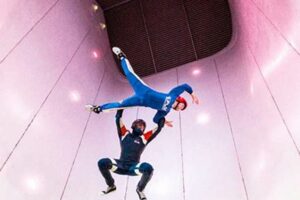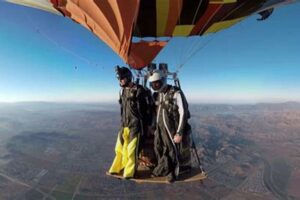Table of Contents
A skydiving altimeter is a wearable device designed to accurately measure altitude during skydives and freefall activities. It provides critical information about the jumper’s height and descent rate.
Skydiving altimeters are essential for ensuring safety, helping skydivers track their altitude, monitor their descent rate, and make informed decisions about deployment and landing. The development of electronic altimeters has significantly enhanced accuracy and reliability compared to traditional mechanical models.
In this article, we will explore the best skydiving altimeters on the market, discussing their features, advantages, and considerations to help you make an informed choice for your skydiving adventures.
Best Skydiving Altimeter
When selecting the best skydiving altimeter, several key aspects must be considered to ensure accuracy, reliability, and suitability for the specific needs of skydivers. These include:
- Accuracy
- Reliability
- Durability
- Functionality
- Ease of Use
- Display
- Battery Life
- Size and Weight
- Cost
Accuracy is paramount, as skydivers rely on the altimeter to provide precise altitude readings during critical phases of the jump. Reliability is equally important, as the altimeter must function flawlessly throughout the skydive. Durability is essential to withstand the rigors of skydiving, including exposure to extreme temperatures and impact forces. Functionality should align with the skydiver’s specific requirements, such as the need for audible alerts or data logging capabilities. Ease of use is crucial to ensure quick and seamless operation, even in high-stress situations. The display should be clear and visible, providing instant access to altitude information. Battery life must be sufficient to cover the duration of the skydive, while size and weight should be considered for comfort and convenience during the jump. Finally, cost is an important factor, as skydiving altimeters can range in price from budget-friendly options to high-end models.
Accuracy
Accuracy is a critical component of the best skydiving altimeter. Skydivers rely on their altimeters to provide precise altitude readings during critical phases of the jump, such as deployment and landing. An accurate altimeter ensures that skydivers have the necessary information to make informed decisions and maintain safety throughout their skydive.
Inaccurate altimeter readings can have serious consequences. If an altimeter overestimates the skydiver’s altitude, they may deploy their parachute too early, resulting in a potentially dangerous high-altitude opening. Conversely, if an altimeter underestimates the skydiver’s altitude, they may delay deployment, leading to a low-altitude opening or even a hard landing.
To ensure accuracy, skydiving altimeters use a variety of technologies, including barometric sensors, GPS, and inertial navigation systems. Barometric altimeters measure atmospheric pressure to determine altitude, while GPS altimeters use satellite signals. Inertial navigation systems use accelerometers and gyroscopes to track the skydiver’s movement and calculate altitude. By combining these technologies, skydiving altimeters can achieve a high level of accuracy, typically within a few feet.
The accuracy of a skydiving altimeter is essential for ensuring the safety and success of a skydive. By providing precise altitude readings, skydiving altimeters help skydivers make informed decisions and maintain control throughout their jump.
Reliability
Reliability is a critical aspect of the best skydiving altimeter. Skydivers rely on their altimeters to function flawlessly throughout the skydive, providing accurate altitude readings even in the most demanding conditions. A reliable altimeter ensures that skydivers can trust the information they are receiving, allowing them to make informed decisions and maintain safety during their jump.
-
Rugged Construction
A reliable skydiving altimeter should be built to withstand the rigors of skydiving, including exposure to extreme temperatures, impact forces, and moisture. It should be constructed from durable materials and sealed to prevent damage from dust and water.
-
Redundant Systems
To ensure reliability, some skydiving altimeters incorporate redundant systems. This means that they have multiple sensors and backup systems to provide accurate altitude readings even if one component fails.
-
Battery Life
A reliable skydiving altimeter should have a long battery life that is sufficient to cover the duration of the skydive, even in cold temperatures. It should also have a low-battery indicator to warn the skydiver when the battery is running low.
-
Proven Track Record
A reliable skydiving altimeter should have a proven track record of performance and reliability. Skydivers should look for altimeters that have been used and tested by experienced skydivers and have a good reputation for accuracy and reliability.
By considering these factors, skydivers can choose a reliable skydiving altimeter that they can trust to provide accurate altitude readings throughout their jump. This will help them make informed decisions, maintain safety, and enjoy their skydiving experience.
Durability
Durability is a critical aspect of the best skydiving altimeter. Skydiving altimeters are subjected to extreme conditions, including high impact forces, temperature fluctuations, and exposure to moisture and dust. A durable altimeter will be able to withstand these conditions and continue to provide accurate altitude readings throughout the skydive.
-
Rugged Construction
The best skydiving altimeters are constructed from durable materials, such as titanium or aluminum alloys, which can withstand the rigors of skydiving. They are also sealed to prevent damage from dust and moisture.
-
Shock Resistance
Skydiving altimeters are often subjected to high impact forces, such as when the skydiver lands. The best altimeters are shock-resistant and can withstand these forces without damage.
-
Temperature Resistance
Skydiving altimeters can be exposed to extreme temperature fluctuations, from the cold of high altitudes to the heat of the sun. The best altimeters are temperature-resistant and can continue to function accurately in all conditions.
-
Water Resistance
Skydiving altimeters may be exposed to moisture, such as rain or snow. The best altimeters are water-resistant and can continue to function accurately even when wet.
By considering these factors, skydivers can choose a durable skydiving altimeter that will be able to withstand the rigors of skydiving and provide accurate altitude readings throughout the jump. This will help them make informed decisions, maintain safety, and enjoy their skydiving experience.
Functionality
Functionality is a crucial aspect of the best skydiving altimeter, as it encompasses the features and capabilities that make the device effective and user-friendly. These features enhance the skydiver’s experience, safety, and decision-making during the skydive.
-
Altitude Measurement
The primary function of a skydiving altimeter is to accurately measure altitude, providing the skydiver with real-time information about their height above the ground. This information is critical for making informed decisions about deployment and landing, as well as maintaining situational awareness throughout the skydive.
-
Audible Alerts
Audible alerts are an essential safety feature, providing the skydiver with audible cues at critical altitudes, such as the deployment altitude or the altitude at which the reserve parachute should be deployed. These alerts help ensure that the skydiver takes appropriate actions at the correct time, reducing the risk of accidents.
-
Data Logging
Data logging allows the skydiver to record altitude and other relevant data during the skydive, such as speed, freefall time, and G-forces. This data can be valuable for debriefing and performance analysis, helping the skydiver identify areas for improvement and enhance their overall skydiving experience.
-
Display and Readability
A clear and easy-to-read display is crucial for the skydiver to quickly and accurately interpret altitude and other information during the skydive. The display should be large enough to be easily visible, even in challenging lighting conditions, and should present information in a logical and intuitive way.
By considering these aspects of functionality, skydivers can choose an altimeter that meets their specific needs and preferences, enhancing their safety, performance, and enjoyment of the skydiving experience.
Ease of Use
In the realm of skydiving altimeters, ease of use is a crucial aspect that directly influences the skydiver’s experience, safety, and decision-making. A well-designed altimeter should be intuitive and straightforward to operate, enabling the skydiver to quickly access critical information and make adjustments without fumbling or distractions.
-
Intuitive Interface
A user-friendly altimeter features a simple and logical interface that allows the skydiver to easily navigate through its functions and settings. Clearly labeled buttons and a well-organized display contribute to a seamless user experience, reducing the potential for confusion or errors during critical moments.
-
Accessible Controls
The altimeter’s controls should be conveniently placed and easy to manipulate, even while wearing gloves or in challenging conditions. Large buttons and tactile feedback provide the skydiver with a positive and responsive user experience, ensuring quick and accurate operation.
-
Clear Display
A well-designed altimeter boasts a clear and easily readable display that presents information in a concise and organized manner. Large digits, high-contrast colors, and backlight illumination ensure that the skydiver can quickly and accurately interpret altitude readings, even in low-light conditions.
-
Customization Options
Advanced altimeters may offer customization options that allow the skydiver to tailor the device to their specific preferences and needs. Adjustable audible alerts, programmable settings, and the ability to switch between different display modes enhance the user experience and cater to the skydiver’s unique requirements.
Overall, ease of use empowers skydivers with greater confidence and control during their jumps. By selecting an altimeter that is intuitive, accessible, and customizable, skydivers can focus on the task at hand, knowing that their equipment is working seamlessly to support their safety and performance.
Display
In the context of skydiving altimeters, the display plays a critical role in ensuring the safety and performance of skydivers. A well-designed display provides the skydiver with clear and easily interpretable altitude information, allowing them to make informed decisions and maintain situational awareness throughout the skydive.
The importance of a clear and effective display cannot be overstated. During a skydive, skydivers often experience high levels of stress and adrenaline, and they need to be able to quickly and accurately read their altimeter to make critical decisions about deployment and landing. A poorly designed display, with small or cluttered digits or inadequate lighting, can make it difficult for the skydiver to read the altimeter accurately, potentially leading to dangerous situations.
Real-life examples of well-designed displays in skydiving altimeters include large, high-contrast digits, backlighting for low-light conditions, and customizable display modes. These features enhance the skydiver’s ability to read the altimeter quickly and accurately, even in challenging conditions. By providing the skydiver with clear and timely information, a well-designed display contributes directly to their safety and overall skydiving experience.
In summary, the display is a critical component of the best skydiving altimeter as it directly affects the skydiver’s ability to make informed decisions and maintain situational awareness during the skydive. By choosing an altimeter with a clear and effective display, skydivers can enhance their safety and performance, ensuring a more enjoyable and successful skydiving experience.
Battery Life
Battery life is a crucial aspect of the best skydiving altimeter, directly impacting the device’s reliability and overall performance during a skydive. A skydiver needs to be confident that their altimeter will have sufficient battery power to last throughout the entire jump, providing accurate altitude readings at all critical stages.
-
Battery Capacity
Battery capacity refers to the amount of electrical energy that a battery can store. A skydiving altimeter with a higher battery capacity will be able to operate for longer periods without needing to be recharged or replaced.
-
Battery Type
Different types of batteries have different characteristics, such as weight, size, and lifespan. Skydiving altimeters often use lithium-ion batteries, which offer a good balance of performance, reliability, and durability.
-
Power Consumption
The power consumption of a skydiving altimeter refers to the amount of electrical energy it uses during operation. Altimeters with lower power consumption will have longer battery life.
-
Battery Monitoring
Battery monitoring features allow the skydiver to track the remaining battery life of the altimeter. This information is critical for planning the skydive and ensuring that the altimeter has sufficient power for the entire jump.
By considering these aspects of battery life, skydivers can choose an altimeter that meets their specific needs and provides the necessary power and reliability for safe and successful skydiving experiences.
Size and Weight
In the realm of skydiving altimeters, size and weight play a significant role in enhancing the overall skydiving experience. A well-designed altimeter should be compact, lightweight, and streamlined to minimize interference with the skydiver’s movements and provide maximum comfort during the jump.
-
Compact Design
A compact altimeter takes up minimal space, allowing the skydiver to wear it comfortably and securely on the wrist or harness. It reduces the risk of snagging or entanglement during the jump, ensuring smooth and safe operation.
-
Lightweight Construction
A lightweight altimeter minimizes the additional weight carried by the skydiver, reducing fatigue and enhancing comfort, especially during prolonged jumps or when carrying additional gear. It allows for greater freedom of movement and agility in the air.
-
Streamlined Profile
A streamlined altimeter has a sleek and aerodynamic design that minimizes wind resistance and drag during freefall. It helps maintain stability and control, allowing the skydiver to focus on maneuverability and precision.
-
Durable Build
Despite its compact size and lightweight nature, a durable altimeter is built to withstand the rigors of skydiving. It should be able to endure impact forces, moisture, and temperature fluctuations without compromising its accuracy or functionality.
By considering these aspects of size and weight, skydivers can choose an altimeter that offers the best combination of comfort, convenience, and performance. A well-designed altimeter will not only provide accurate altitude readings but also enhance the overall skydiving experience, allowing the skydiver to focus on the thrill and beauty of the jump.
Cost
In the realm of skydiving, cost plays a significant role in determining the quality and capabilities of a skydiving altimeter. The price of an altimeter is often indicative of its features, accuracy, reliability, and durability. Higher-priced altimeters typically offer more advanced features, such as audible alerts, data logging, and GPS integration, which can enhance the safety and performance of the skydiver.
Cost is a critical component of the best skydiving altimeter because it directly affects the device’s ability to provide accurate and reliable altitude readings. Cheap altimeters may be less accurate and less durable, which can lead to dangerous situations in the sky. Investing in a high-quality altimeter is essential for ensuring the safety of the skydiver and for making informed decisions during the jump.
Real-life examples of the connection between cost and quality in skydiving altimeters are evident in the market. Budget-friendly altimeters typically have limited features and may not be as accurate or reliable as their more expensive counterparts. Mid-range altimeters offer a balance of features and reliability, while high-end altimeters are designed for professional skydivers and offer the most advanced features and the highest level of accuracy.
Understanding the relationship between cost and the best skydiving altimeter is crucial for skydivers of all levels. By considering the importance of accuracy, reliability, and durability, skydivers can make informed decisions about the altimeter that best meets their needs and budget. Investing in a high-quality altimeter is an investment in safety and performance, ensuring a more enjoyable and successful skydiving experience.
Frequently Asked Questions
This section addresses common questions and concerns regarding the selection and use of the best skydiving altimeters, providing further insights and clarifications to enhance your understanding.
Question 1: How do I choose the right skydiving altimeter for my needs?
Consider factors such as accuracy, reliability, durability, functionality, ease of use, display, battery life, size, weight, and cost to determine the altimeter that best aligns with your specific requirements and preferences.
Question 2: What features should I look for in a high-quality skydiving altimeter?
Essential features include high accuracy, a reliable design, durable construction, intuitive interface, user-friendly controls, clear display, customizable options, and sufficient battery life to cover the duration of your skydive.
Question 3: How can I ensure the accuracy of my skydiving altimeter?
Regularly calibrate your altimeter according to the manufacturer’s instructions and consider using a backup altimeter for added redundancy. Additionally, compare your altimeter readings with those of other skydivers or use GPS data for cross-checking.
Question 4: What are the safety considerations when using a skydiving altimeter?
Always inspect your altimeter before each skydive to ensure it is functioning properly. Familiarize yourself with the audible alerts and warning indicators, and trust the readings provided by your altimeter to make informed decisions throughout your jump.
Question 5: How can I extend the lifespan of my skydiving altimeter?
Handle your altimeter with care, avoiding rough handling or extreme temperatures. Clean it regularly to remove dirt and moisture, and store it in a dry and protected environment when not in use. Follow the manufacturer’s guidelines for maintenance and servicing to ensure optimal performance and longevity.
Question 6: What are the legal requirements for using a skydiving altimeter?
Regulations regarding the use of skydiving altimeters may vary depending on your jurisdiction. Consult with local skydiving organizations or authorities to determine any specific requirements or recommendations for your area.
These FAQs provide valuable insights into the selection, use, and maintenance of the best skydiving altimeters. By understanding these aspects, you can make informed decisions and enhance your safety and performance during your skydiving adventures.
The next section will delve into the technical specifications and advanced features of skydiving altimeters, further assisting you in choosing the optimal device for your needs.
Tips for Selecting the Best Skydiving Altimeter
When choosing the best skydiving altimeter, there are several crucial factors to consider. Here are some essential tips to guide your decision-making process and enhance your skydiving experience:
Consider Your Needs: Identify your specific requirements, such as accuracy, reliability, durability, and features. Determine the type of skydiving you engage in and the features that are most important for your safety and performance.
Research and Compare: Explore different skydiving altimeter models, compare their specifications, and read reviews from experienced skydivers. This will help you understand the strengths and weaknesses of each device.
Prioritize Accuracy: Accuracy is paramount for skydiving altimeters. Choose a device that provides precise altitude readings, ensuring you have the necessary information to make informed decisions during your jump.
Consider Reliability: Your skydiving altimeter should be reliable and function flawlessly throughout your jump. Look for devices with rugged construction, redundant systems, and a proven track record of performance.
Check Functionality: Evaluate the altimeter’s functionality, including audible alerts, data logging capabilities, and display options. Ensure that the device meets your specific needs and preferences.
Ensure Ease of Use: Choose an altimeter that is easy to use, with an intuitive interface and accessible controls. This will allow you to quickly and accurately interpret altitude readings, even in challenging conditions.
Consider Display Quality: A clear and visible display is crucial for quickly reading altitude information. Look for altimeters with large digits, backlighting, and customizable display modes.
Factor in Size and Weight: Choose an altimeter that is compact and lightweight to minimize interference with your movements during the jump. A well-designed device will provide comfort and convenience.
By following these tips, you can select the best skydiving altimeter that aligns with your specific needs and enhances your overall skydiving experience. Remember, a reliable and accurate altimeter is a vital safety tool that contributes to your enjoyment and success in the sport.
In the next section, we will delve into the advanced features and technical specifications of skydiving altimeters, providing further insights to help you make an informed decision.
Conclusion
In exploring the best skydiving altimeters, we have uncovered the critical factors that contribute to their effectiveness and reliability. Accuracy, durability, functionality, ease of use, size, weight, and cost are all interconnected aspects that influence the selection of the optimal altimeter for each skydiver’s needs. By understanding these factors and considering the tips provided, skydivers can make informed decisions that enhance their safety and performance during their jumps.
Ultimately, choosing the best skydiving altimeter is about finding the device that seamlessly aligns with your individual requirements and preferences. Whether you prioritize accuracy, durability, or advanced features, the insights provided in this article will guide you towards making the right choice. As you venture into the thrilling world of skydiving, remember that a reliable and accurate altimeter is your steadfast companion, providing the critical information you need to navigate the skies with confidence and precision.







